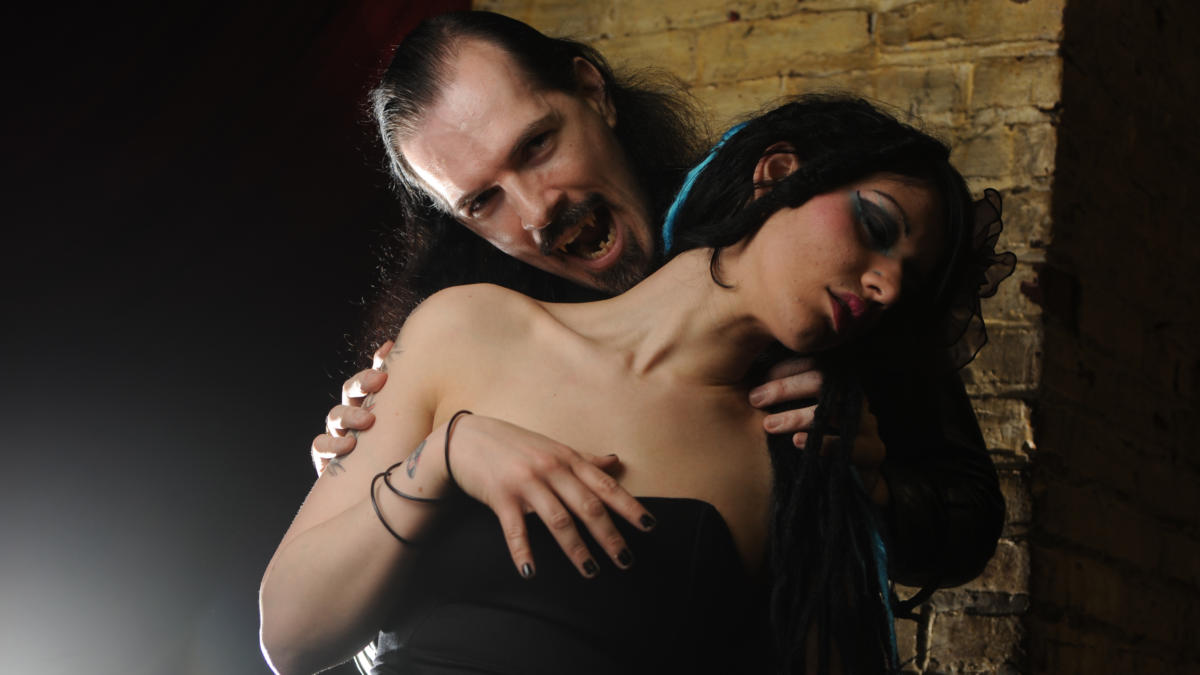On a Thursday afternoon in mid-March, Patrick Rodgers – Philadelphia’s famously fanged, premier promoter of all that is Gothic, vampiric and industrial, be it music, art or food – is performing many the same tasks as every American at present: dealing with the personal and business hassles of coronavirus.
As the owner and operator of Dancing Ferret Concerts, he’s monitoring the moving parts of a health care crisis that finds his punkish shows in March on hold, or pushed to later dates.
Rodgers is also running errands, putting the finishing touches on his May 1’s Dracula’s Ball at the Franklin Music Hall. Ripped from its roots at The Trocadero upon its closing late last year, the world’s biggest vampire-themed live concert and party event, presently featuring the legendary UK Goth-tinged band Stabbing Westward, will celebrate its 75th iteration and will, as always, welcome vamps from around the globe.
“I’m culturally, spiritually and intellectually curious,” said Rodgers, when asked who exactly he is. “A citizen of the world. A professional facilitator who is capable of making nearly impossible things happen. Someone with a clearly defined moral code. A person more likely to run toward sirens than away from them.”
Oddly, he never mentions anything Goth or vampire-related, right, despite those things being the most vividly notorious aspects of his appearance.
The bigger point here is that, despite having fangs, a dedication to the ancient imagery of vampirism and most things Gothic, Rodgers is not worried about sunlight or any of the icy trappings of Dracula-ian mythology. As a culinary aficionado who has traveled the world and thrown rare menu dining parties throughout the city (such as the first Irigoyen dinner), he’s really cool with garlic and would always choose to drink wine over blood if he drank at all (he’s a straight-laced, non-drug or drink teetotaler always). And, with a forever-present manicured goatee such as his and a predilection for leather pants, he’s likely fond of mirrors.
“I can state that Patrick doesn’t dig daylight, but that’s just because he stays up late to work and likes his sleep,” said old friend and Metropolis Records’ label owner Dave Heckman, refuting any fear that Rodgers could burn up into ash and cinder at the first sight of dawn’s sun streaming rays. “He was born in the Bahamas, you know?”
Rodgers joked that, quite simply, “’Awake early’ is a relative term for me.”

Then again, Rodgers’ newest venture beyond Dracula’s Ball and moving impending Goth rock live programs and programs, has had him up morning and night, writing, editing and independently publishing his first novel, “Even Goblins Get The Blues.”
Due for release in April, his fantastical writing debut finds Rodgers peering into yet another twilight world, the imaginary Sapphire City, where the lone therapist in town takes on the psychic woes and mental health issues of the town’s goblins, dragons, mermaids, and minotaurs.
If Neil Gaiman had ever written an episode of “The Sopranos” with Dr. Melfi tending to a Centaur Tony Soprano – with just a hint of William S. Burroughs’ smugness and alien sensuality – that would be the tone, texture and feel of “Even Goblins Get The Blues.”
And though the noir creatures of “Goblins” come across, at first, like some of the club denizens that Rodgers has served in a vampire-ish scene of his own devising – with Rodgers as their leader-therapist – the author-entrepreneur is quick to disabuse any notions of similarity.
“Abernathy (the book’s therapist) isn’t an aspirational model or an idealized version of myself,” said Rodgers. “I believe in diplomacy, and I love helping other people when I can, but I don’t have his level of serenity and I’m not sure I’d want it. … When I’m running an event, I do feel a duty of care to my patrons, in much the same way that Abernathy does to his patients, so we share that.”
What Rodgers, his audiences and his closest associates also share is the love of all that is Gothic in music, art and literature, with the occasional thing for vampire imagery and idealism.
“The Gothic, yes, I get that, but the fascination with the vampire thing, I’ve no idea,” said photographer, international Goth-industrial scene chronicler and friend Kyle Cassidy. “It seems like so much work. I used to wonder if David Bowie ever ran out to the supermarket in sweat pants with no product in his hair. Some part of this subculture is extremely meticulous. But there are so many branches in that tree. I’m more the ‘Siouxsie’ T-shirt and black jeans’ variety. But I think that that is Patrick’s whole thing – everybody is welcome. You don’t have to be a vampire, you don’t have to have a rubber dress, you don’t have to memorize Ozemandias, you don’t have to crimp your hair and put on mascara to be part of our group … it’s a big tent and there is room in it for many.”
How Rodgers got to be so magnanimous (in the eye of his fans and friends), or get here, period, with the Goth, the industrial, the leather, and the fangs, starts far away in a distant land. Not Philadelphia or the Sapphire City of his new “Goblin” novel, but rather the sun, surf and sand of the Bahamas where he was born and raised.
By the way. No. He’s never given or is giving his age or stated what year he was born. Don’t ask.
The most anyone has ever known about dates related to Rodgers – whether it’s his friends, or even I, the author of the piece who long ago ran, did events and-or promoted clubs such as Revival, the Trocadero, Asylum, The Bank, etc. – is that he just sort-of popped-up in Philly around the beginning of the ‘90s. Sans fangs.
“I’m from Freeport on the island of Grand Bahama, and moved to the U.S., alone, in the late ‘80s,” said Rodgers. “There was really nothing to do on the island – how many times can you go to the beach? – so I was very bored.”
Rodgers brought with him a voracious appetite for books, games and notions of business, and was completely unprepared for the culture shock he felt from the vibrancy of a bustling city. “It was a jarring adjustment period.”
The move from running around the Bahamian sands in the sunshine to becoming the goateed prince of midnight was easily facilitated when you consider that Rodgers never did much sand dune-ing in the first place. His misspent youth was mostly filled with times “climbing over the fence to a large hotel nearby and trying to sneak into tourist activities as I could, or just picking fruit from the hotel fruit trees until guards in golf carts would chase me down.”
Both of his parents were successful independent entrepreneurs on the island, so Rodgers learned that skill and savvy from his folks. Finding lost golf balls in the bush and selling them to tourists at a price well beneath what the pro shop at the hotel charged was how Rodgers’ art of the deal was built.
“The other transformative experience was my first exposure to music from outside the Caribbean,” he stated. “We had plenty of soca, reggae and calypso, but we’d very occasionally pick up radio from Miami and that was mostly Latin or Latin-influenced music, and television stations from Miami. As this was during the advent of the music video, I was suddenly thrown into the world of Duran Duran, Michael Jackson, The Police, David Bowie and others.”
The fascination with the Gothic? “Even when I was young, I felt like the villains always got short shrift in the movies. The entertainment industry, then, was very lazy and villains were always doing inexplicable things that came back to bite them in the ass, like being incredibly abusive to their underlings. ‘That’s no way to inspire loyalty and run an operation,’ I’d think. So I always had an interest in the monster/villain’s point of view and that was one pathway to the dark side.”
Aesthetically, too, Rodgers couldn’t deny the appeal of Goth – spidery bands coming from the UK in the late ‘70s and early ‘80s such as Bauhaus, Specimen, Dead Can Dance, The Cult and more. Dressed all in black and done-up in teased-high hair and think kohl eyeliner, The Cure and Siouxise & the Banshees were particularly ominous and fashionable. “Those cats looked so badass. … While I can appreciate the beauty of a tanned swimsuit model, I grew up on beaches full of that, and so the pale girls in fishnet with their clove cigarettes were exotic and intriguing to me.”
The vampy 1987 teen-action-mystery-movie “The Lost Boys” was a seminal film for Rodgers, one that showed vampires as young, attractive, live-for-the-moment types rather than decrepit old men. “Kiefer Sutherland made it seem like a great life,” said Rodgers with a laugh.
Fun then, rather than the misery and morbidity that usually follows Goth’s usual vibe is what fascinated Rodgers, who, in the early ‘90s, fell into Philly’s VERY nascent goth scene by accident (he wasn’t a club go-er or a partier) when he attended a vampire-related activity at Asylum. “I heard songs that I owned and loved and I’d think, ‘This is goth? I listen to this all the time. I guess I must like goth music; better listen to more of it.’”

In reality, by the early ‘90s and the rise of goth-industrial acts such as Nine Inch Nails, Marilyn Manson, Ministry and My Chemical Romance, it was better to be making and promoting the music than passively listening.
After having been gainfully employed by a local video arcade owner, Rodgers dove in with a first show at the Troc in 1995 with X-Cops (the guys from GWAR but dressed up as evil cops) financed through a cash advance on the one credit card that he had. “That was an expensive loss… no local band in a church basement; it was quite an initiation into the business.” His second and third shows, though, turned a profit as the audience for goth-industrial sound grew and the vamp scene became more pronounced and ready to pounce.
He created club nights such as Wednesday night Nocturne parties at Shampoo, which, by 2008 hit its 12-year mark, to become the longest-running weekly club night in Philadelphia. He started the quarterly Dracula’s Ball parties that welcomed vamps from around the globe. He became THE promoter and booker of large-scale goth music in the area, with sold-out shows from the likes of The Sisters of Mercy and Dead Can Dance being 100 percent Dancing Ferret (Rodgers said that the upcoming Dead Can Dance show in April at the Met is 100 percent Live Nation. “They hired me to help publicize, but, that is not at all my show”)
To further satiate that hunger in the ‘90s, Rodgers began booking and promoting goth and industrial concerts and making and selling records through his own label under his Dancing Ferret Entertainment Group umbrella. By time the label started, Rodgers had enough cash flow that he could put out several records, back-to-back, and see how it went. They sold like hot cakes, and several of Dancing Ferret’s releases hit the top of several Billboard charts. “Music From The Succubus Club,” a soundtrack to the pen-and-paper game “Vampire: The Masquerade” and a record from a now-defunct German band, Paralysed Age, were the Dancing Ferret label’s first hits.
“The funny thing is that I had no interest in starting a label,” said Rodgers. “I shopped these projects to all the goth labels that I knew from my experience as a promoter and they all passed. I knew the projects would succeed so I started my own label.”
That prowess as a promoter brought him to the attention of the local goth-industrial scene’s other magnate, Dave Heckman. Philly’s Heckman came up as part of the area’s glam punk scene, and by 1991 owned the Digital Underground record store on South Street (which eventually moved to South 5th St. and was later occupied by Rodgers). By 1995, however, his love of music turned toward goth industrial and import-only bands such as Front 242, and his place started to become a hangout mecca for goth kids in fishnets.
“There were industrial nights at Trocadero that were packed, mixing up old school industrial with Jane’s Addiction and Jesus and Mary Chain records, recalled Heckman. “It was a cool scene. So, I focused Digital Underground’s attention on goth and industrial, which I have to say was ambitious, and a little crazy. Eventually, it worked out, because the record store was so successful, I started licensing music from Germany and Belgium – the biggest territory for this music, with bands such as Front 242 at its forefront – and started Metropolis to focus more on signing bands.”
While Heckman’s Metropolis signed old guard bands such as Frontline Assembly and KMFDM and new bands such as Ego Likeness, Dancing Ferret Discs put out records by Angelspit, Carfax Abbey, Qntal, Gothminister, and even author Neil Gaiman.
Heckman had a talent for finding the music, but in his own words, “sucked at promoting it.” Bring in Patrick Rodgers for reinforcement, and a goth-industrial universe exploded, and its audience forever dedicated – a dedication that, despite the slowing of CD sales, has kept the niche music empowered and profitable, while maintaining a community of people enthralled with Rodgers and all things Dracula-ian and Gothic. As far as a following went, at one-time Rodgers’ publication, “Asleep By Dawn Magazine,” had around 30,000 subscribers in the area.
“Patrick has been and is always at the frontline of promoting this music and the Philly scene,” said Heckman with a laugh. “He loves Philly. And he loves to schmooze. He is the focus of his clubs, the main man – always has been.”
As the main attraction among the fire breathers, contortionists and pierced performers of his Nocturne parties and Dracula’s Balls, past and present, Rodgers is a grand ringmaster. But a quiet one, one who holds court easily, and simply, by being himself.
Rodgers’ club events, then and now, are built on a business model of all ages, all the time. “But, as the under-21 crowd has largely disappeared at the club level, we’ve been forced to start doing some 21-plus events. As a non-drinker, I’ve never liked the idea of keeping people away from concerts because of alcohol, but that’s just the new reality.”
The all-ages vampire-inspired, Goth scene that Rodgers built and kept through to the present is filled with many, but best witnessed by Kyle Cassidy, a West Philadelphia-based photographer with famous clients ranging from Amanda Palmer to Weird Al Yankovic. Cassidy has documented his fascination with American gun owners in “Armed America: Portraits of Gun Owners in Their Homes,” captured tattooed veteran soldiers in “War Paint: Tattoo Culture & the Armed Forces,” and had his photos from the early days of Occupy Wall Street published in the Huffington Post and the Bluestocking Gallery.
“Without Patrick, we’d all just have been watching Cure videos on MTV’s ‘120 Minutes,’ and thinking that’s about as cool as things got,” stated Cassidy with a laugh.
As for Rodgers’ pointy fangs, a point of curiosity for most, they seem common now, as innate a part of his being as his arm or his mustache.
“My current set was done for me in the mid-90s by a dentist now retired. I have very weak enamel which led to a lot of dental issues, including numerous root canals. I’d spent a lot of money with him, so while he was initially hesitant, he ultimately agreed to do them for me – after hours and off-book, of course. As for ‘why,’ that’s hard to answer beyond saying it just felt right. Some people have tattoos, some have piercings, some have other body mods. The fangs just looked and felt so natural on me, as if they were meant to be there all along.”
The moment where everything of Rodgers – street smarts, righteous indignation, sense of fair play, business acumen and fangs – were on their fullest display wasn’t during a Dracula’s Ball or a Dead Can Dance concert, but rather during the mortgage mess of 2011 when Wells Fargo Bank tried to foreclose on his house because they wanted him to carry a million dollars’ worth of insurance on an $180k home.
“They tried that, and I told them that it wasn’t happening – I’d never missed a single payment,” said Rodgers. “So I learned a lot about real estate law and sued them, while serving as my own attorney. I wound up ‘foreclosing’ on them and got a Sheriff’s Sale placed against Wells Fargo’s Philadelphia office.”
“The fascination with [sic] Goth?…When I was young, I felt like the villains always got short shrift in the movies. The entertainment industry, then, was very lazy and villains were always doing inexplicable things that came back to bite them in the ass…so I always had an interest in the monster/villain’s point of view and that was one pathway to the dark side.”
– Dracula’s Ball creator Patrick Rodgers
To say that the story went wildly viral on social and mass media is no exaggeration. The tale of how the little guy beat back and took on the big guy made Rodgers beloved and famous around the globe. One particular chat with CNN host Don Lemon in July 2011 featured a fanged Rodgers talking about money lenders as thieves in the temple and spouting wizened, passionate legalese as if he were Atticus Finch.
“Media outlets around the world requested my attention and I did a number of TV interviews, one of which has a million-plus views on YouTube. I wound up appearing on ‘The Colbert Report,’ which was absolutely hilarious and a wonderfully fun time. And, of course, Wells Fargo offered me a delightful settlement. Suffice to say there’s no mortgage on my house anymore.”
As far as business goes, Rodgers works with AEG, Live Nation, Cirque Du Soleil and the Pennsylvania Ballet, who have hired him to promote events that appeal to the Dancing Ferret’s core goth-vamp audience. Yes, catalog CD sales have slowed, but streaming is fantastic, and goth-industrial music is as sturdy a sales niche as any brand. Along with that comes greatly anticipated tours from legends such as a reunited Bauhaus, Dead Can Dance and My Chemical Romance, to say nothing of Dancing Ferret Concerts’ Front 242 show at Underground Arts this September.
When I ask if mermaids and dragons were any sort of replacement for vampires when writing his novel, “Even Goblins Get the Blues,” Rodgers stopped me and stated that he never felt any sense of obligation to make his debut by writing about vampires.
“The subject I chose resonated with me for a number of reasons, not the least of which being that I felt that fantasy was how we viewed our idealized selves: bold, heroic, brave, legendary,” said the author. “And yet one of fantasy’s foundational tropes, whether in stories or games, is this idea of slaughtering intelligent beings at will simply because they are different, stealing everything they own, and then heading off to the local tavern to brag about it. Our fantasy heroes see goblins as ‘monsters,’ but, one imagines that goblins see our heroes as monsters, too. I wanted people to think about how quickly we rationalize or excuse any atrocity as long as it’s committed against someone sufficiently different from us.”
As for tackling the matter of mental health in such a manner, Rodgers claimed that placing a lone therapist in a fantasy world where psychology effectively doesn’t exist allows the book to examine basic questions such as ethics, confidentiality, and what an actual therapy session looks like, even if the patient is a minotaur. “This may result in some readers who have viewed therapy with hesitation to consider giving it a try,” said Rodgers. “I’m also a big believer in empathy and cultural engagement, and exploring the question of why we view others as ‘monsters’ gives ample opportunity to show those virtues in action.”
As for going forward, Rodgers said that he’d love to guide Dracula’s Ball to its hundredth iteration, that he’ll take on new ventures and keep traveling the world as he has the last few years. He’d love to do an international hip-hop festival here in Philly and bring in bands from all over the world.
“With every lawsuit I’m involved in, there’s always someone encouraging me to become a lawyer. If a new distribution partner came along to take over from Amazon Prime, a second season of my talk show, ‘Interviewed by a Vampire,’ would not be out of the question. I think I spent enough of my life on an island where there was such a small set of possibilities that part of me wants to try as many things as I realistically can succeed.”
And as for the fascination with all that is vampirism – legend and present day – and how has it changed Patrick Rodgers’ life for the better, he claimed that it has helped to shape and reinforce his belief that generally, hostility and war are things that happen between governments, whereas individual humans tend to be more open and welcoming.
“Going to North Korea, Iran, Cuba and other places as an American is something people might consider noteworthy, but going there as an American vampire is a bat of a different color. I hope others will think that if a freaky dude with fangs and a trench coat is treated well by people in his travels, then surely other Americans would also be welcome in those countries. Another benefit is that some people tend to underestimate me once they look up my photo. Being taken lightly has been a tremendous asset to me both in business and in court. By the time people figure out that they should have been taking me seriously, I’ve usually gotten what I wanted.”





